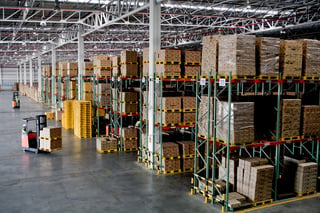WiFi for Large Warehouses: The 5 Most Common Mistakes
 WiFi networks for warehouses: a notoriously difficult challenge. Here are the five most common mistakes made when setting up warehouse WiFi networks.
WiFi networks for warehouses: a notoriously difficult challenge. Here are the five most common mistakes made when setting up warehouse WiFi networks.
With the increasing prevalence of smart devices and now even internet-enabled forklifts, warehouse stock can now be monitored and managed in near-real-time. This represents a huge advantage to an industry that has long relied on unwieldy paper trails to manage valuable inventory. But these advantages also place large burdens on warehouse WiFi networks. At the same time, warehouses are in many ways the worst possible spaces for WiFi: they’re large, full of obstacles, fluctuating user densities, and constantly changing inventory.
Needless to say, when it comes to designing high-performing WiFi networks, warehouses are notoriously difficult environments. Although many warehouses are many tens of thousands of square feet or larger, their size isn't even the biggest challenge when it comes to delivering effective wireless connectivity. The complexity and constant fluctuation of both interior environments and user needs make warehouse WiFi design one of the most daunting challenges in the industry. Identifying a suitable WiFi solution for your warehouse comes down to understanding which technologies can meet the needs of your space, your employees, and your business. So what should you consider before investing in a warehouse WiFi solution?
Turning Up The Power
Increasing the power of your access points might seem like an obvious solution. However, this tactic is often counterproductive as it can increase interference and cause devices to connect to the wrong (i.e. further) access points.
Furthermore, client signal strength is often the bigger problem than access point strength. Cell phones and laptops have weaker RF signals than access points, and increasing an AP’s power cannot help the signal strength in the other direction. Again, it will just create confusion as clients try to communicate with access points that are too far away.
In the absence of a professional WiFi network installer, the best strategy is to set access point power at 50% and adjust it up or down marginally as needed.
AP Design
Several common warehouse WiFi problems find their source in the design and layout of access points. Ideally, enterprises should bring in professionals for a wireless site survey before they install their network; even if an initial site survey wasn’t done before, it can still prove immensely valuable.
Too Few or Too Many Access Points
Determining the correct number of access points for any given space requires an in-depth process. Factors to consider include coverage (the size and shape of your space) and more importantly capacity (the number of clients being served and types of work being done).
Lacking sufficient access points could leave parts of your warehouse with poor coverage or render your existing access points overwhelmed by the number of clients. But installing too many access points has disadvantages too. If the range of access points overlaps, their radio frequencies can interfere with each other and disrupt service.
Poor Access Point Placement
In most interior spaces, access points are commonly installed on ceilings, however, warehouse ceiling heights are often over 30 feet. Installing access points on the ceiling of a warehouse could put them out of range for most clients on the warehouse floor.
The layout and materials inside of a warehouse are also critical factors to consider when determining the correct placement of access points. WiFi signals will penetrate better in a warehouse storing mattresses or apparel than a warehouse storing auto parts or building materials. Plus, wooden pallets and metal shelving create additional obstacles for signals — the fact that these items are regularly moved around doesn’t help.
Cages are often overlooked as barriers to WiFi signals. If there are storage cages in the warehouse where WiFi is needed, be sure to place an access point inside the cage itself. And if vehicles like forklifts have onboard computers that need WiFi, remember to extend the antenna outside the metal cab of the vehicle.
Not Updating Firmware
Maintaining the firmware for access points is a crucial part of network integrity. However, many warehouse networks do not update their firmware regularly. While computers and phones prompt users regularly for updates and can even force them automatically, firmware updates often must by specifically sought out and implemented by network administrators. Firmware updates not only help boost the performance of your network, they also help protect it from security threats. Warehouse network administrators can (and should) sign up for alerts from the access point manufacturer for firmware updates.
Not Auditing Regularly
Planning and implementing an effective warehouse WiFi network is a challenge — or, indeed, a major accomplishment if done correctly. But it needs to be part of an ongoing process of feedback and adjustment to ensure long term success. Make sure to regularly check that capacity (and coverage) are both still at desirable levels. Be sure to adjust your plan when relevant factors, like the layout or materials inside the warehouse, are significantly altered.
Not Performing A Wireless Site Survey
Having a wireless site survey performed is one of the most important things you can do before setting up (or upgrading) a warehouse WiFi network. Bringing in experienced professionals to evaluate your WiFi needs will help ensure that the resulting network delivers both superior service and optimal cost-efficiency. It can help take the guesswork out of many of the factors mentioned here, for example, analyzing how to deliver sufficient capacity throughout the space while taking into account layout, materials, and client needs.
With nearly three decades of experience designing and installing high-performing warehouse WiFi networks, the IT professionals at Turn-key Technologies (TTI) are capable of handling all of your wireless networking needs. Contact us today to learn more about what a wireless site survey could do for your warehouse network — whether you’re installing a new one, or improving an existing one.
About Tony Ridzyowski
Tony Ridzyowski leads the Inside Sales Team at Turn-key Technologies, Inc., where he also supports marketing, partner strategy, training, and CRM operations. Since joining TTI in 2014, Tony has earned top producer honors and President’s Club recognition. With a background in network cabling and experience working with Fortune 500 clients like Wells Fargo and Countrywide Home Loans, Tony brings decades of industry insight to every customer conversation.




